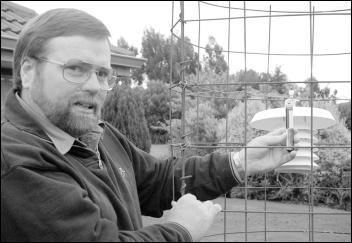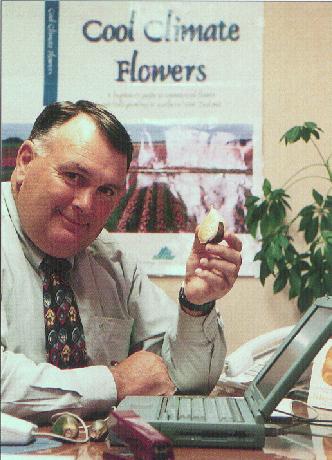
-
Jobs from the land
Mapping Microclimates in Southland
from The Jobs Letter No.86 / 1 September 1998
While the "new economy" of information technology and services may be seen as the employment of the future rural New Zealand is looking at fresh ideas on how to gain a good livelihood beyond the traditional dairy and sheep farming. In Southland, a collaborative effort between local councils, government agencies and community groups is quickly becoming a "flagship" initiative for rural communities who want economic development and real jobs.
Topoclimate South Trust is undertaking a major infrastructure project which will provide essential information on Southland and South Otago soils and climate and will open up new land use opportunities. The key to the project is using high-tech data-loggers to map the pockets of land in the region that could support intensive horticulture.

Project Manager Gary Hutchinson says that there are large areas of first-class soil in Southland and Otago with only a limited understanding of where they were and what could be grown on them. Mapping the favourable micro-climates will ultimately lead to their economic development.
A major backer of this initiative is Crops For Southland, a focus group comprising commercial interests, farmers, growers, scientists and the regional and territorial local authorities, which has long been active in researching crops that can be grown in the region. (These include Meadowfoam, Boronia, Cranberry, Gentians, Paeony, Valerian and Wasabi).

Crops For Southland co-ordinator Wayne Hutchinson says one of the main constraints to the sustainable development of horticulture in the region was the lack of reliable information on the soils and climate within potential production areas. Providing this information has long been identified by farmers and local agencies as a key factor in unlocking the economic potential of the region.
The Topoclimate South project will take about 3-5 years. Property owners on whose land the data-loggers are positioned are being offered a free copy of a 1:100,000 scale map of the soils in their area as well as information on which pockets of their land will support different levels of "growing degree day" (GDD) heat. Topoclimate South also plans to set up an information bureau to help landowners further develop their specific horticulture potential.
Crops For Southland board member and local apiarist Murray Ballantyne, says that, in the past, a lot of people went sour about alternative land use because they hadn't planted in the right places, or worked as part of a group to see their products marketed properly. Ballantyne sees the topoclimate project as enabling intelligent and informed decisions to be made about alternative land uses.
The job creation potential inherent in "unlocking the regions resources" is considerable. Topoclimate South quotes research by the Dutch government which says that one extra job is created for every hectare converted to intensive horticulture. In addition to this, an extra eight positions are created downstream. There is no equivalent research for NZ conditions, and the Southland groups are taking a more conservative predictive approach, saying that they believe there will be an extra job created for every hectare of horticulture developed in the region with four more jobs downstream. The Crops For Southland target for the year 2000 is 5,000 jobs. Even with this conservative prediction, and if only 0.5% (5,000 hectares ) of the 852,000 hectares to be surveyed by Topoclimate South went into horticulture, there could be up to 20,000 01 cellspacing=0
|
|
Naturally, it is the prospect of job creation that has seen the Topoclimate South project attract support from a wide range of authorities and groups. The Southland Community Trust was a major contributor. Other supporters have been the Southland Regional Council, the Southland District Council, Gore District Council, Invercargill City Council, and the Clutha District Council.
Internet bookmark: The Topoclimate South website is at http://www.topoclimate-south.co.nz/.
Crops For Southland has a database of over 1,200 people who are growing and trialing new crops in the region. One of the offshoots of its projects has been Hydrangea Hunters and Gatherers. The project, which involves over 168 women gathering the common hydrangea blooms for sale to USA, has allowed low income earners, beneficiaries and retired women to supplement their income.
Ministry of Agriculture and Fisheries Rural Policy Manager Ann Pomeroy reports that most Southlanders have hydrangeas growing in sheltered areas behind their houses, which provide the protection that they need. These plants need this micro-climate to survive and produce their distinctive blooms. As a result, it is not the sort of flower that can be produced through planting large fields, so when hydrangeas were identified as an export crop, a different method of harvesting was needed.
The blooms were collected from backyards of the "exporters", who were mostly elderly women (with an average age of 74). Seven people are employed in the packing shed to sort, treat and process the flowers. A letter is distributed to the "exporters" informing them of the best products and practices in order to improve the quality of their blooms. This year there are 367 growers on the database, and production, at 35,000 stems is still not meeting the present demand of 60-90,000 stems. Markets in France and Switzerland have also expressed their interest in hydrangeas. The plant, which everyone once took for granted, is now part of a community tourism promotion to be planted along the main road, to create the "Hydrangea Highway".
"Strategies Contributing to Employment Generation in Country Areas in New Zealand" is the title of a paper presented to a conference in Canberra earlier this year by Dr Ann Pomeroy. She argues that the future wellbeing of rural areas will not come from government edicts but from "the dynamism of local initiative". She believes that government needs to understand this and adopt "a brokerage and partnership role" rather than providing subsidies or dominating in the development of policy.
Pomeroy: "By shifting emphasis onto capacity building to meet diverse local needs, new structures and processes can be put in place to integrate local need with central policies and overcome development barriers. Co-operation and partnerships between different groups within a community and between community and service providers is an important starting point for finding innovative ways to build enterprise opportunities"
The Pomeroy paper available on the MAF website at http://www.maf.govt.nz/MAFnet/publications/empstrat/httoc.htm
Sources Otago Daily Times 20 February 1998 "Land mapping may lead to creation of 20,000 jobs", "Putting microclimates on the map", "Devices record temperature data", by John Stirling, available on internet at http://www.odt.co.nz/20Feb1998/index-800.html (see features section on site)
"Strategies Contributing to Employment Generation in Country Areas in New Zealand" Paper presented to the ABARE OUTLOOK Conference Canberra 3-5 February 1998 by Dr Ann Pomeroy, Manager Rural Affairs and Social Science Policy Ministry of Agriculture, New Zealand, available on the internet at http://www.maf.govt.nz/MAFnet/publications/empstrat /httoc.htm

Top of Page
This Letter's Main Page
Stats |
Subscribe |
Index |
The Jobs Letter Home Page |
The Website Home Page
jrt@jobsletter.org.nz
The Jobs Research Trust -- a not-for-profit Charitable Trust
constituted in 1994
We publish The Jobs Letter








